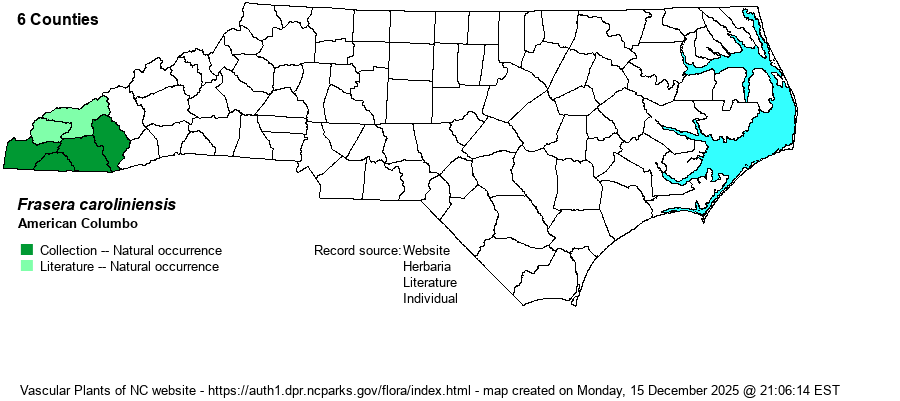| Author | Walter | |
| Distribution | Limited to the southwestern corner of the state -- Cherokee, Graham, Clay, Swain, Macon, and Jackson counties.
This is a Midwestern species, ranging east to western NY, OH, KY, southwestern NC, and western SC. It is not yet known from WV or VA. | |
| Abundance | Uncommon to locally numerous in much of Clay and Macon counties, but generally rare in the other counties. This is a Significantly Rare species, with a State Rank of S2. | |
| Habitat | This is a species that requires rich, high pH soil. It grows in Rich Cove Forests and adjacent bottomlands, but it can be seen along the edges of some such rich forests; it may also grow in more mesic forests, as long as the soil is of quite high pH. |
| Phenology | Blooms from late May through June; fruits from September to October. | |
| Identification | This is such a robust herb, among the tallest such plants in the state, that even without seeing the stem, the huge basal leaves are so impressive that once you see the species, you never forget it. The species has very long, tobacco-like leaves in a basal rosette, each one being 8-12 inches long and 3-4 inches wide, oblanceolate with entire margins, quite thick and shiny. The plants stay in such a rosette, adding a leaf every year, and after a handful of years, a tall flowering stem emerges and grows to 5-9 feet tall, after which the plant dies. There are several whorls of stem leaves, averaging 4-8 leaves per node, and these are narrowly elliptic to oblanceolate, mostly ascending, the lower ones up to 8-10 inches long but progressively smaller up the stem. The top 12-18 inches of the stem consists of the huge and pyramidal panicle of large flowers, typically several dozen flowers in the cluster. Each flower consists of 4 (to rarely 5) dull yellow-white to greenish-white petals, each with purple spotting and a large green gland at the base. The spread flower is slightly over 1-inch across. This spectacular and unforgettable plant is not overly difficult to find in parts of Clay and Macon counties in rich forests, and thankfully the plants can be seen by walking road margins; though the plants normally do not grow along wooded borders, the clump of large basal leaves is easily spotted somewhat back from the wooded edge. | |
| Taxonomic Comments | Earlier references named the species as Swertia caroliniensis.
| |
| Other Common Name(s) | Yellow Gentian | |
| State Rank | S2 | |
| Global Rank | G5 | |
| State Status | SR-P | |
| US Status | | |
| USACE-agcp | | |
| USACE-emp | | |

